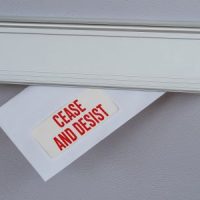Four Elements of a Cease-and-Desist Letter to Stop Trademark Infringement

Is another business or organization infringing on your company’s trademark? You have the right to take legal action to hold them accountable. A cease and desist letter is a useful tool to address trademark infringement at the earliest possible level. To be truly effective, a cease and desist letter must be properly drafted. Here, our Boca Raton cease and desist attorney highlights four key elements that should be included in a letter aimed at stopping trademark infringement.
- State the Nature of the Trademark Infringement
As a general rule, a cease and desist letter for a trademark violation should begin by identifying the alleged infringement. You should include sufficient details for the recipient to understand the situation without adding unnecessary information. Along with other things, relevant details include:
- Your trademark, including registration details;
- The recipient’s offending mark; and
- A description of how the infringer’s use of a similar or identical mark on related goods or services is likely to cause confusion among consumers.
- Emphasize the Strength of Your Trademark
The USPTO notes that a valid trademark is a legally enforceable intellectual property (IP) right. If you have a valid trademark, you have the right to enforce it. As part of your cease and desist letter, you should be prepared to emphasize the strength and value of your trademark. Explain how it is distinctively associated with your goods/services in the minds of consumers. If applicable, mention the length of time the trademark has been in use and the geographical extent of its recognition.
- Indicate Your Intent to Take Legal Action if Infringement Continues
The goal of a cease and desist letter is to stop trademark infringement. With this in mind, you should clearly state that if the infringing activities do not cease, you are prepared to take legal action to protect your intellectual property rights. You should always stress the seriousness with which you view the infringement and your commitment to enforcing your rights through litigation if necessary. However, express a preference for resolving the matter amicably.
- Include a Clear Deadline for a Response
Finally, a cease and desist letter for trademark infringement should include a deadline for a response. As a best practice, you should specify a clear and reasonable deadline. The date should provide enough time for them to review the claim and seek legal advice but should not be so distant as to delay resolution. Notably, your cease and desist letter should indicate the actions you expect them to take by this deadline—such as stopping all use of the infringing mark and confirming their compliance in writing. In some cases, you may even be seeking payment of damages.
Contact Our Florida Cease and Desist Letter Attorney Today
At Perkins Law – Brand Protection, our Florida trademark attorney has extensive experience with cease and desist letters. If you have any questions or concerns about the elements of a cease and desist, we are here to help. Reach out to us by phone or contact us online to set up your completely confidential initial appointment. We provide IP law services throughout all of Southeast Florida.
